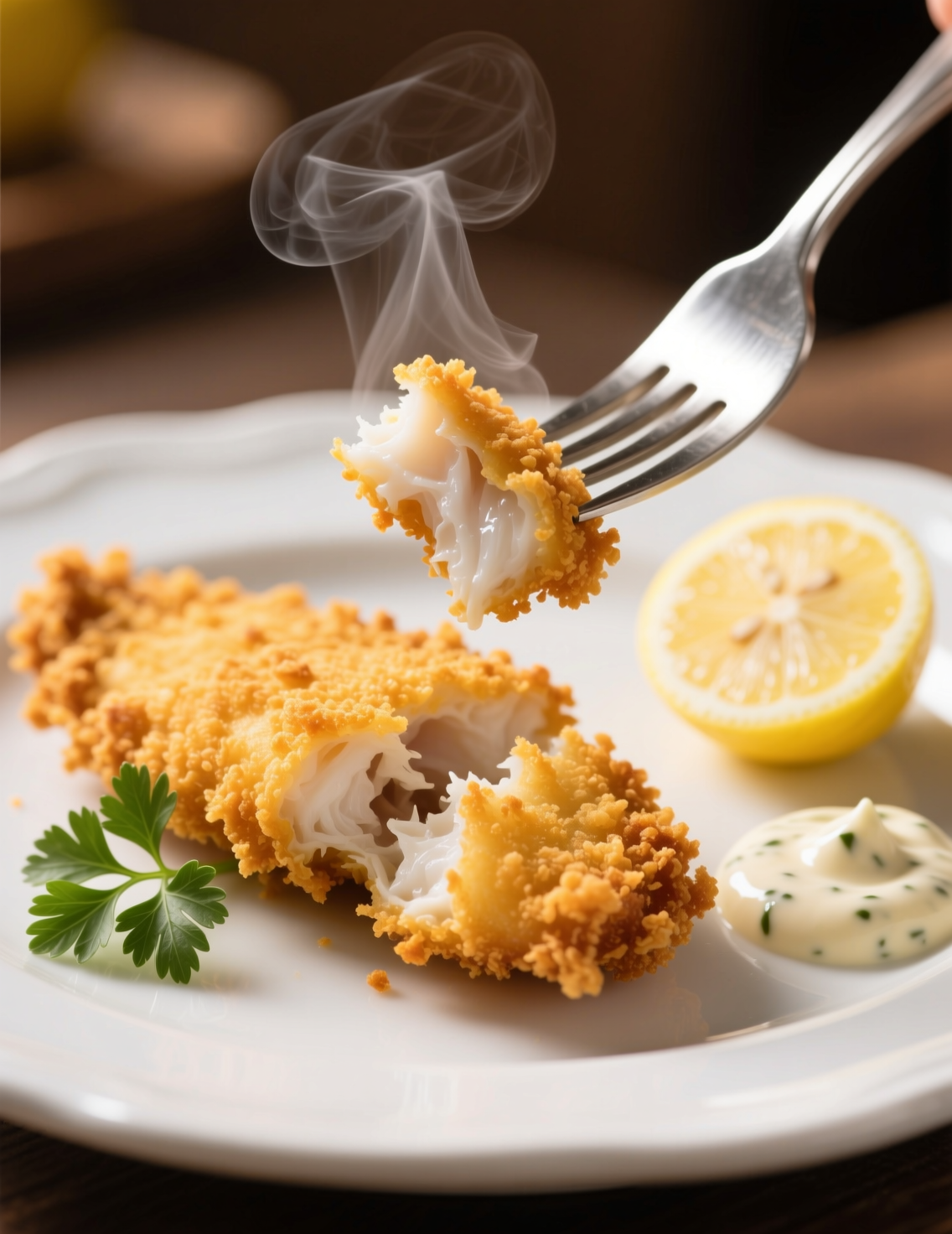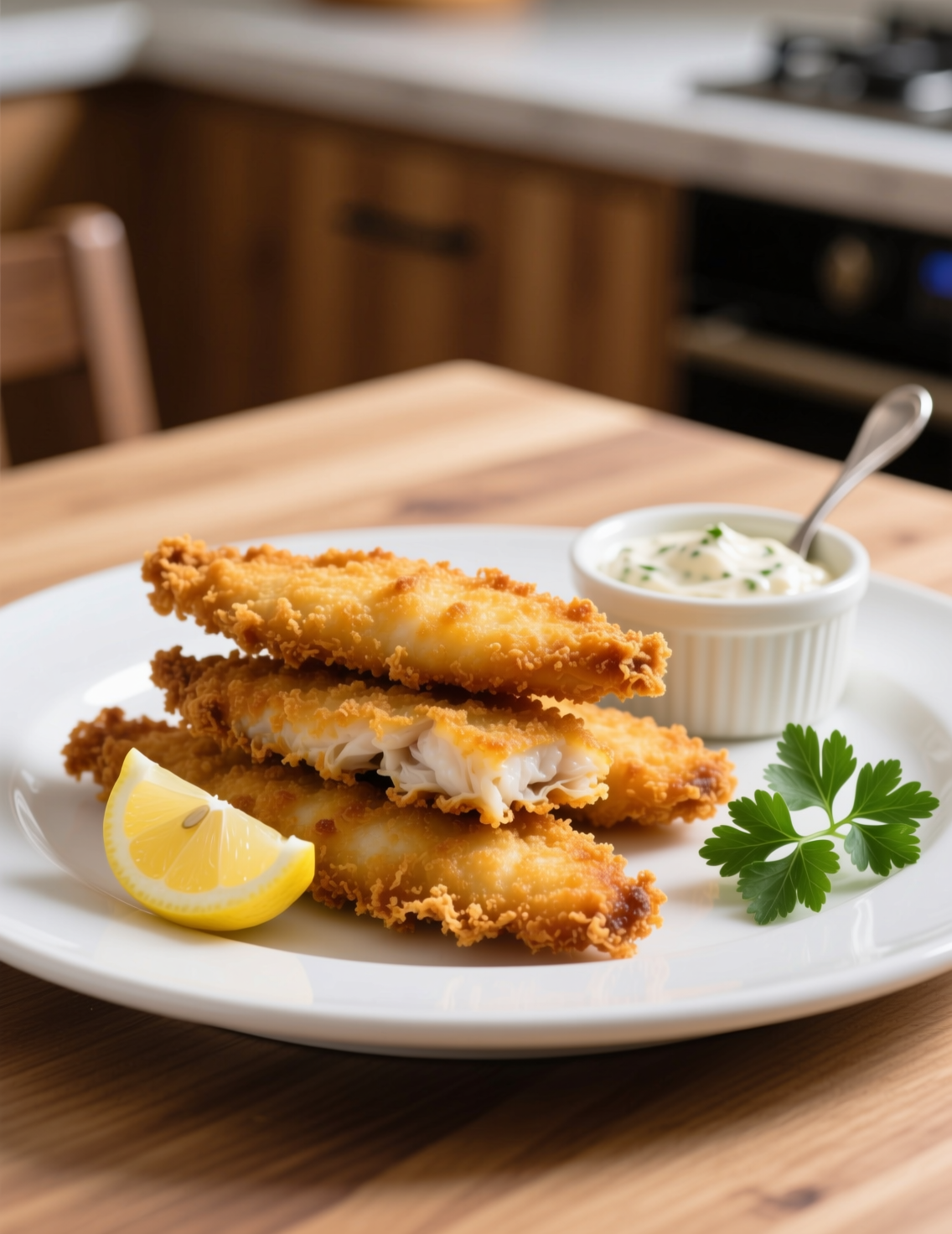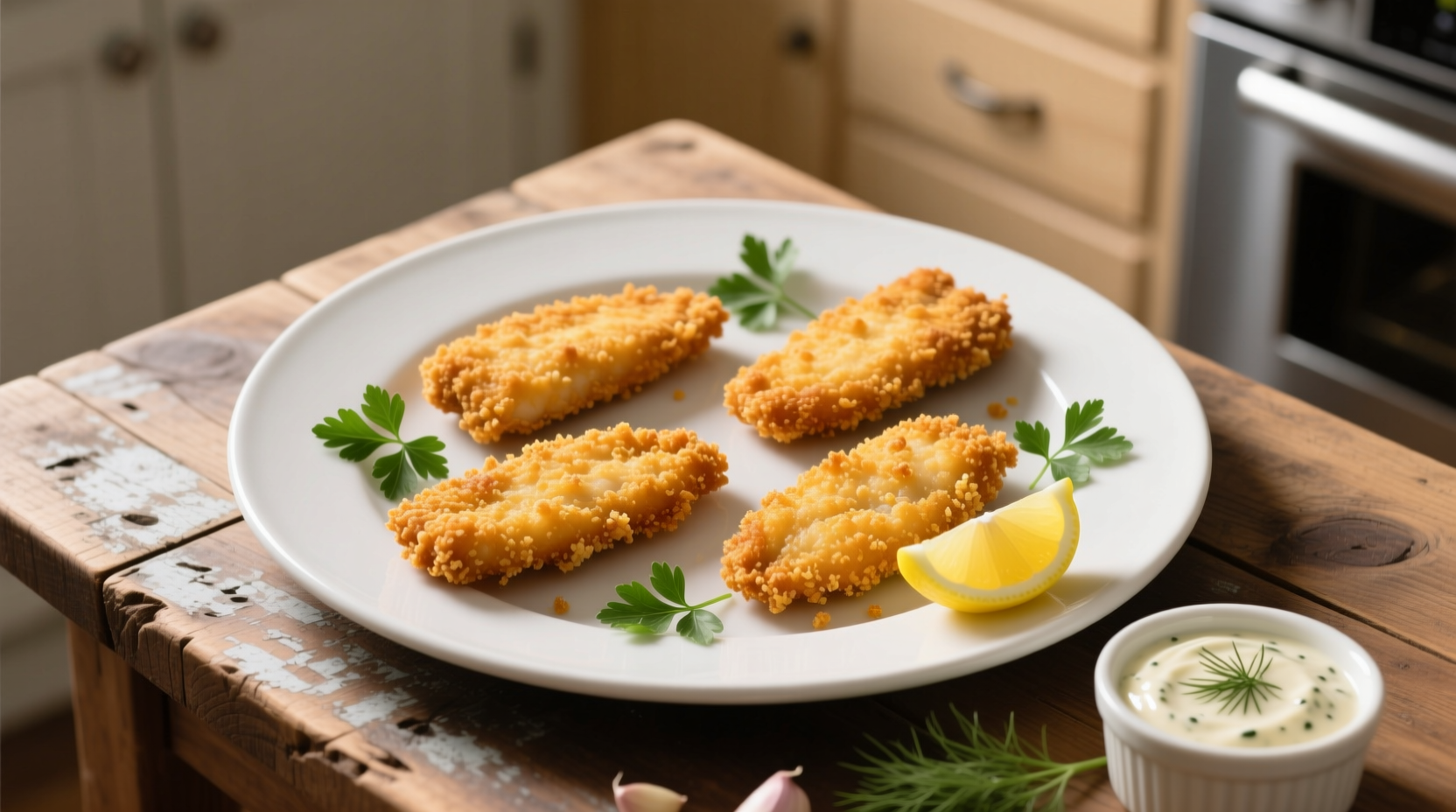Fish has always been one of those foods that people either nail or completely ruin. Frying it in oil used to be the classic route, but the air fryer has rewritten that story. It’s faster, lighter, and makes a crust that crackles when you bite into it. In this article, I’ll walk you through a professional-level, yet totally approachable method for making crispy air fryer fish fillets in just 7 steps. Four servings, perfect for a weeknight, and smart enough to land on a restaurant menu if you tweak it right.
Why Air Fryer Fish Works So Well
When you think about frying, oil temperature is king. In traditional frying, if your oil dips below 350°F, your fish drinks up grease like a sponge. But with an air fryer, the heat is circulated by a fan at blazing speeds. That circulation gives you crispiness without drowning the fillet in oil.
A study from the Journal of Food Engineering compared hot air frying with deep frying. It found that air-fried foods absorbed up to 70% less oil while still producing similar crisp textures. That’s not just a calorie win—it’s a flavor win. Too much oil masks the taste of the fish itself. With air frying, the flesh stays clean, light, and flaky, while the crust steals the show.
Choosing the Right Fish
Not every fish behaves well in an air fryer. Delicate fillets like sole or flounder break apart too easily. You want firm, flaky fish that holds its structure under heat. Cod, haddock, tilapia, pollock, and even catfish fit beautifully.
Thickness matters. A fillet around ½ to ¾ inch thick cooks evenly without drying out. Thicker fillets? You risk a raw center before the coating browns. Thinner than that? They dry faster than a forgotten baguette.
Frozen fish fillets? They can work if thawed completely and patted dry. Moisture is the enemy of crisping. Any excess water steams the coating instead of crisping it.
Essential Ingredients for Maximum Crisp
Now let’s break down what makes a crust really sing. It’s not just breadcrumbs slapped on fish. Professionals know the layering technique is what matters. Here’s a base recipe for four servings:
- 4 firm white fish fillets (about 5–6 oz each)
- 1 cup all-purpose flour, seasoned with salt and pepper
- 2 large eggs, beaten with a splash of water
- 1 ½ cups breadcrumbs (panko is king for crunch)
- 1 teaspoon smoked paprika
- ½ teaspoon garlic powder
- ½ teaspoon onion powder
- 1 teaspoon lemon zest
- Salt and pepper to taste
- Olive oil spray (or avocado oil spray for higher smoke point)
Notice the lemon zest in the crumbs? That tiny detail wakes up the flavor. Professional chefs often build in a layer of brightness because fried foods can feel heavy.

Step-by-Step Method: The 7 Moves That Matter
Step 1: Prep the Fish
Pat each fillet dry with paper towels. This isn’t a throwaway step—it’s the make-or-break. If the surface is wet, the flour won’t stick, and your coating slides right off. Season the fish lightly with salt and pepper.
Step 2: Set Up Your Dredging Station
Three bowls: flour in the first, eggs in the second, breadcrumbs mixed with spices in the third. Keep everything close because once you start dredging, you don’t want to hunt for things. Professionals call this mise en place, and trust me, it saves you.
Step 3: Coat the Fish Properly
Dip fillet into flour, shaking off excess. Then dunk in egg wash, letting the drip fall off. Finally, press firmly into breadcrumbs. Don’t just roll it—press. That pressure fuses crumbs into the surface. Without it, you’ll have bald spots.
Step 4: Rest Before Cooking
Let the coated fillets sit on a tray for 10 minutes. This resting time lets the coating hydrate slightly and cling better. Skip this, and the crust can peel during cooking.
Step 5: Preheat the Air Fryer
Run your air fryer at 400°F for 3 minutes before adding fish. Preheating ensures immediate searing of the crumbs. Drop cold fillets into a cold fryer, and you’ll regret it.
Step 6: Spray Generously with Oil
A light spritz of oil on both sides creates that golden crunch. Too little oil and your crumbs dry out, looking pale and sad. Too much, and you defeat the purpose of air frying. A thin, even mist is perfection.
Step 7: Cook to Golden Perfection
Lay fillets in a single layer, leaving space between them. Cook at 400°F for 8–10 minutes, flipping once halfway. Timing depends on thickness—check for an internal temperature of 145°F. That’s USDA-approved safe and ensures juicy flakes.
Tips from Professional Kitchens
Here’s where experience kicks in. Restaurants often use panko breadcrumbs because they’re airy and jagged, creating more crunch. Mixing in crushed cornflakes? Adds an even sharper bite.
Don’t overcrowd the air fryer basket. Airflow is the secret weapon here. Cramming too many fillets means uneven cooking. If you’ve got more fish than room, cook in batches.
Flavor layering is your friend. Add fresh parsley or dill to the crumb mix for a herbaceous lift. Or swap paprika for cayenne if you want a kick. Even parmesan cheese blended into crumbs adds savory depth.
Nutritional Insights
One 5-ounce portion of air fryer fish prepared this way contains roughly:
- 260–300 calories
- 22 grams of protein
- 9 grams of fat (depending on oil spray)
- 20–25 grams of carbs
Compared to traditional deep-fried fish, which can hit 450+ calories per serving, this is a significant cut. And because you’re not soaking the fish in oil, the omega-3s remain more intact, making this a heart-smart choice.
Common Mistakes to Avoid
Some folks forget to preheat the air fryer. That’s like searing steak on a cold pan—it doesn’t work. Others overload the basket. Air fryers need circulation, not compression.
Another misstep is skipping seasoning in the flour. That first dusting sets up flavor that carries through every bite. Bland flour equals bland fish, no matter how good your crumbs are.
And here’s a quirky one: don’t line the basket with parchment unless it’s perforated. Solid parchment blocks airflow, which wrecks crisping.
Variations for Different Tastes
Professionals love to experiment. You can swap breadcrumbs for almond flour if you’re going low-carb. Try crushed tortilla chips for a Tex-Mex twist. Even Japanese tempura flakes, if you can find them, take the crisp to another level.
Seasonings can be tailored. Add curry powder to the crumb mix for an Indian spin. Or go Mediterranean with oregano, thyme, and grated lemon zest. Each variation keeps the method but changes the mood.

Pairing Ideas and Serving Suggestions
Crispy fish fillets pair beautifully with tangy sauces. Classic tartar sauce works, but so does a garlic aioli or yogurt dill dip. For starch, think roasted potatoes, couscous, or even a bright quinoa salad.
Vegetables shouldn’t play second fiddle. A side of grilled asparagus or a slaw with apple and cabbage adds crunch and acidity. These contrasts balance the richness of the crust.
And if you’re plating for guests, a wedge of lemon on the side isn’t just garnish—it’s function. A squeeze of lemon sharpens the flavor profile instantly.
Emerging Trend: Air Fryer as Everyday Tool
The air fryer isn’t just a fad. A 2024 report from Statista showed that nearly 65% of American households own one. Professional kitchens aren’t using them en masse, but chefs often keep a unit in the back for small-batch tests. The ability to replicate fried texture without vats of oil has changed home cooking.
More importantly, consumer demand for healthier fried foods is pushing restaurants to rethink technique. What we see at home often drifts into commercial kitchens within a decade. Air fryer fish might just be an early preview of mainstream menus.
Final Thoughts
Crispy air fryer fish fillets sound simple, and yes, they are. But when done with care—proper coating, rest time, preheat, oil misting—they rival deep-fried versions without the heaviness. The seven steps aren’t just instructions, they’re principles. Skip one, and you’ll notice.
For four servings, this recipe is efficient, light, and endlessly adaptable. Whether you’re feeding a family or refining a personal technique, air fryer fish fillets prove that modern cooking doesn’t need to compromise on flavor or texture. If you treat each step like it matters, you’ll get fillets that crunch, flake, and make people think you’re running a kitchen out of your home.
FAQs
Can I use frozen fish fillets in the air fryer?
Yes, but thaw them fully and pat dry to avoid soggy coating.
What’s the best fish to use for this recipe?
Firm white fish like cod, haddock, tilapia, or pollock works best.
Do I need to preheat the air fryer?
Yes, preheating ensures even crisping and proper browning.
How do I make the coating extra crispy?
Use panko breadcrumbs and press them firmly onto the fish.
Can I cook multiple fillets at once?
Yes, but don’t overcrowd the basket or they won’t crisp evenly.
How long does it take to cook air fryer fish fillets?
Typically 8–10 minutes at 400°F, depending on thickness.
What internal temperature should the fish reach?
Fish should reach 145°F for safe and juicy results.
Can I make this recipe gluten-free?
Yes, just use gluten-free breadcrumbs or almond flour.
What sauces pair best with crispy fish fillets?
Tartar sauce, garlic aioli, or a lemony yogurt dip all pair beautifully.
How many servings does this recipe make?
The recipe makes 4 servings, perfect for a family meal.

Mariana is a passionate home cook who creates delicious, easy-to-follow recipes for busy people. From energizing breakfasts to satisfying dinners and indulgent desserts, her dishes are designed to fuel both your body and hustle.
When she’s not in the kitchen, she’s exploring new flavors and dreaming up her next recipe to share with the Foodie Hustle community.

